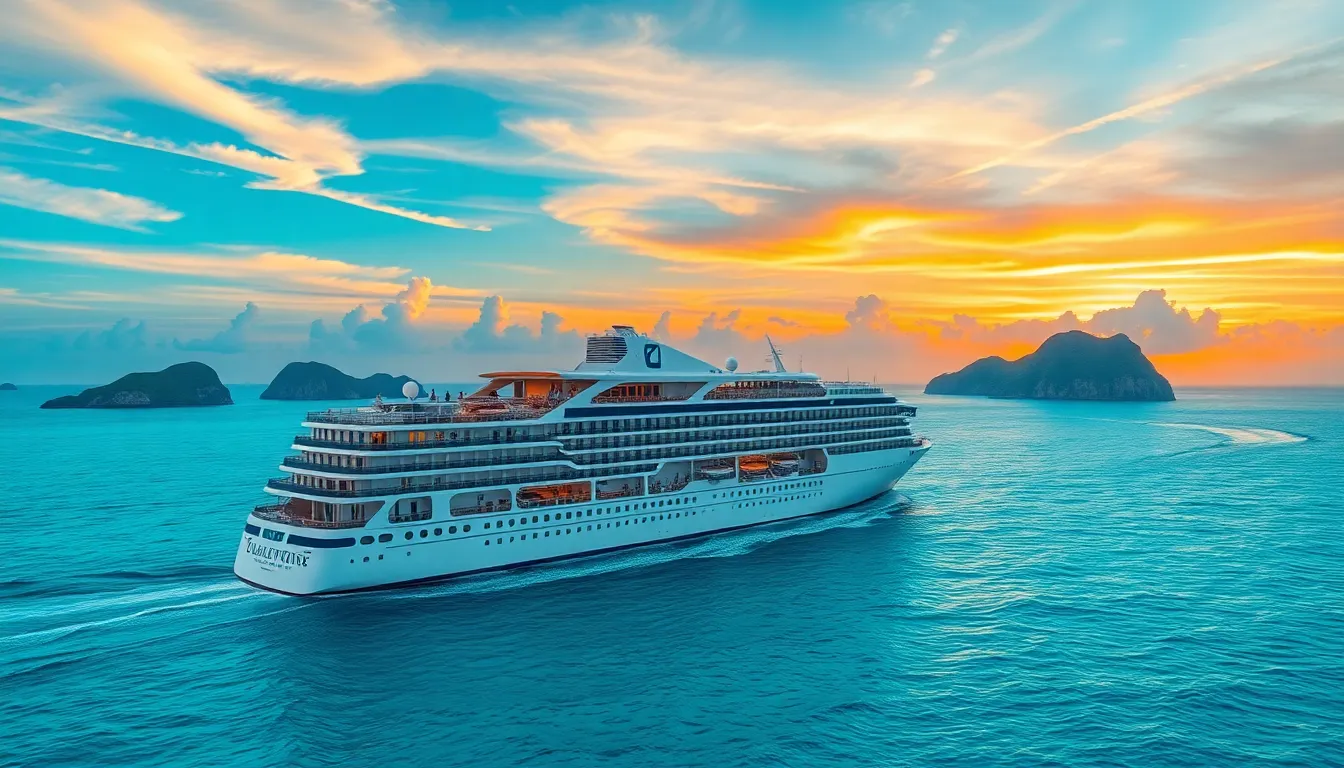Table of Contents
TogglePlanning a vacation can be exciting yet overwhelming, especially when it comes to budgeting. Cruises offer a unique way to explore multiple destinations while enjoying luxurious amenities. However, the question on everyone’s mind is, “How much is a cruise per person?”
Understanding the costs involved is crucial for making informed decisions. Factors like cruise line, destination, duration, and cabin type can significantly affect the price. With a range of options available, from budget-friendly to extravagant, it’s essential to know what to expect before setting sail. Whether it’s a romantic getaway or a family adventure, knowing the average cost can help travelers plan a memorable experience without breaking the bank.
Overview Of Cruise Costs
Understanding cruise costs helps travelers budget effectively for their trips. Average price ranges depend on several factors, including cruise line, destination, duration, and cabin type.
| Factor | Average Cost Range (per person) |
|---|---|
| Budget Cruises | $50 – $150 per night |
| Mid-Range Cruises | $150 – $300 per night |
| Luxury Cruises | $300 – $1,000+ per night |
Cruise line selection significantly impacts expense. Lines like Carnival and Royal Caribbean offer budget-friendly options, while upscale lines like Seabourn and Silversea command higher prices, reflecting enhanced services.
Destination influences rates, with Caribbean cruises averaging lower costs than Alaskan or European itineraries. Duration also affects pricing; shorter cruises can be more economical, averaging around four to five days, while longer cruises (seven days or more) often provide better per-day rates.
Cabin types range widely in cost. Inside cabins cost less, averaging around $50 to $150 per person per night. Ocean-view and balcony cabins typically range from $150 to $300 per person per night, providing more space and better views.
Additional expenses often arise beyond the base fare. Travelers may account for onboard activities, specialty dining, excursions, and gratuities, which can add $100 to $500 or more to the total trip cost.
Factors Influencing Cruise Prices

Cruise prices vary based on several key factors. Understanding these elements helps in making informed decisions while budgeting for a cruise.
Cruise Duration
Cruise duration significantly impacts price. Longer cruises, typically lasting seven nights or more, often present lower per-night costs due to economies of scale. Shorter cruises, usually lasting three to five nights, tend to be priced higher per night, as cruise lines optimize revenue for the limited time. For example, a five-night cruise may cost $1,200 total, averaging $240 per night, while a week-long voyage could cost $1,500 total or around $214 per night.
Destination Choices
Destination choices also play a crucial role in determining cruise prices. Popular regions like the Caribbean usually offer budget-friendly options due to high competition. Conversely, itineraries to Alaskan or European destinations may carry higher prices due to increased demand and limited availability, often ranging from $200 to $600 per night based on the route. Specialty destinations can affect overall expense, so researching specific locales provides valuable insight into expected costs.
Cabin Selection
Cabin selection directly influences the overall cruise price. Inside cabins serve as the most economical option, typically priced between $50 and $150 per night. Ocean-view cabins increase the cost, usually ranging from $150 to $300 per night, while balcony cabins can start at $300 and surpass $1,000 per night for luxury options. The choice of cabin type affects one’s onboard experience; therefore, it is essential to balance comfort preferences with budget constraints.
Average Price Ranges
Cruise prices vary significantly based on multiple factors, including cruise line, itinerary, and cabin type. Understanding these price categories helps travelers make informed decisions.
Budget Cruises
Budget cruises typically cost between $50 and $150 per person per night. Lines such as Carnival and Royal Caribbean provide affordable options that attract travelers seeking value. These cruises often include basic amenities, such as dining and entertainment, with additional costs for specialty dining, excursions, and beverage packages. Caribbean itineraries frequently fall within this price range, making them ideal for budget-conscious travelers.
Mid-Range Cruises
Mid-range cruises usually range from $150 to $300 per person per night. Cruise lines like Norwegian and Princess offer enhanced amenities, including a variety of dining options and upgraded entertainment. These cruises often feature more comfortable accommodations and destinations that appeal to a wider audience, including European and Alaskan itineraries. Travelers can expect added benefits like guided excursions and premium alcohol packages, which enhance the overall experience.
Luxury Cruises
Luxury cruises come with a price tag of $300 to $1,000+ per person per night. High-end lines like Seabourn and Silversea deliver exceptional service, gourmet dining, and exclusive experiences. These cruises often include all expenses, such as excursions, specialty dining, and onboard gratuities, making them a more comprehensive option. Unique destinations and personalized services cater to discerning travelers seeking unforgettable experiences, justifying the higher costs associated with these voyages.
Additional Costs To Consider
Travelers should account for additional costs beyond the base fare when budgeting for a cruise. These expenses often enhance the overall cruise experience but can add significantly to total trip costs.
Onboard Expenses
Onboard expenses can vary widely. Travelers may encounter costs for specialty dining, drinks, and spa treatments.
- Dining Options: While complimentary meals are available, specialty restaurants usually charge an extra fee, ranging from $15 to $60 per person.
- Beverages: Most cruise lines charge for alcoholic drinks and specialty coffees, with cocktails averaging $10 to $15 each.
- Activities: Some activities, like cooking classes or wine tastings, may require a fee that can be between $20 and $100, depending on the experience.
- Gratuities: Daily gratuities are common, typically around $15 to $20 per person, added automatically to onboard accounts unless otherwise stated.
Shore Excursions
Shore excursions often represent a significant expense, providing travelers unique experiences at various destinations.
- Types of Excursions: Excursion prices range from $50 for basic tours to over $300 for premium experiences, such as private tours or adventure activities.
- Booking Options: Booking through the cruise line offers convenience but often at a premium. Travelers can also explore independent providers for potentially lower prices, enhancing savings.
- Considerations: Excursions usually require advance planning. Travelers should evaluate excursion descriptions and associated costs to find the best fit for their interests and budgets.
Tips For Finding The Best Deals
- Book Early: Securing reservations in advance often leads to lower prices. Many cruise lines provide early booking discounts.
- Be Flexible: Allowing flexibility in travel dates can unlock significant savings. Off-peak seasons typically feature lower prices compared to peak travel times.
- Compare Prices: Utilizing price comparison websites helps identify competitive rates across various cruise lines and itineraries, ensuring the best deal.
- Sign Up for Alerts: Subscribing to newsletters and fare alerts from cruise lines and travel websites keeps travelers informed about promotions and special offers.
- Consider Last-Minute Deals: Occasionally, cruise lines offer discounted rates to fill remaining spots close to the departure date. Monitoring these deals can yield substantial savings.
- Join Loyalty Programs: Many cruise lines have loyalty programs that reward repeat customers with discounts, upgrades, and exclusive deals.
- Book Bundled Packages: Purchasing cruise packages that include airfare, excursions, or other amenities can often reduce overall costs. This simplifies planning and may present additional savings.
- Consult Travel Agents: Experienced travel agents often have access to exclusive offers and can provide valuable insights when planning a cruise.
- Research Group Discounts: Traveling with a group can lead to substantial savings. Many cruise lines offer special rates for larger parties.
- Examine Onboard Promotions: Keep an eye on onboard credits or discounts available for specialty dining and activities during promotional periods. These can enhance the cruise experience at a reduced cost.
By following these tips, travelers can optimize their cruise experiences while managing expenses effectively.
Understanding the costs associated with cruises is essential for any traveler looking to embark on this unique adventure. With a range of options from budget to luxury cruises there’s something for everyone. By considering factors like cruise line destination duration and cabin type travelers can make informed decisions that suit their preferences and budgets.
Additionally it’s crucial to factor in extra expenses such as onboard activities and shore excursions which can significantly impact the overall cost. By employing smart strategies like booking early and exploring various options travelers can enhance their cruise experience without breaking the bank. With the right planning a cruise can be both memorable and affordable.




